Free weight exercises contribute to many aspects of different types of training such as strength training, functional training and bodybuilding. It is a versatile type of exercise that is of great assistance to your goals.
I never want to be bulky so I was afraid of doing dumbbell exercises and the like for many years. Until I trained for functional fitness, I had never understood nor wanted to understand free weights.
Now, I can proudly say that I enjoy utilising free weights in my sessions because I know its benefits and that it will not make me a bulky woman when used the right way.
Follow along as I introduce you to a variety of exercises you can do with free weights at home or in the gym.

How to Maximise the Benefits of Free Weight Exercise Routine?
Before jumping straight into performing some best free weight exercises, it is good to have the best preparations in order to maximise the benefits this exercise provides.
Here are some things you need to do before engaging in free weight exercise sessions for your goal:
Setting a Goal
First things first, set a goal. What do you want to achieve over a period of training with free weight workouts?
Are you wanting to increase muscle size and increase strength or build endurance? Having a clear goal in front of you would help formulate what sort of weights you need for your exercise.
Setting a goal would also help you to stick with the routine and be more focused on achieving the result you are after.
Once you have set your goal, you will know how heavy the weights should be for your training. In general, heavier weights help build strength and muscle size while lighter weights are good for endurance.
The type of training will matter too as it will affect the number of reps and how much rest you get between sets.
For increasing strength and size, the number of reps should be lower and more rest between sets. Meanwhile, a higher number of reps with less rest between sets is suitable for endurance-type goals.
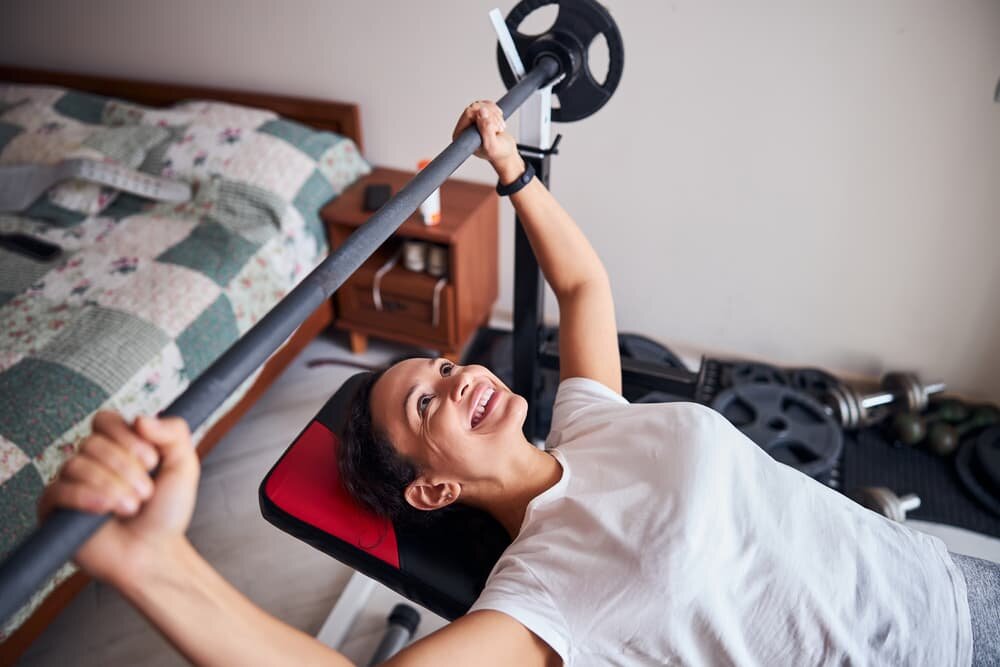
Proper Form
This is an extremely important point to note because not only you will not benefit from the exercise without proper form, you could potentially injure yourself.
Having a proper form when doing free-weight exercise movements is imperative. Learn with a personal trainer or watch the specific movements from YouTube before going straight in with the weights.
A best practice is to practice the movements using only your body weight first until you are familiar with the movements before adding weights.
Poor forms can lead to devastating injuries like sprains, torn muscles, ligaments, and broken bones. Never try to show off by using weights heavier than you are used to.
It is always better to start with body weight before moving on to lighter weights. Advance to heavier weights gradually only when you are stronger.
Remember: Lifting lighter weights with proper form is better than lifting heavy weights with poor form.
Recovery is Important
You may think that lifting weights is not the same as cardio exercises so it does not tire you up easily. Wrong! Lifting weights is tiring. You expand a lot of energy into doing those movements, balancing yourself and holding up the weight.
Like any exercise, recovery is key to being able to perform better and promotes muscle healing so you can work better each time you train. Try not to train the same muscle groups back to back. Give them time at least 1 full day to recover and repair.
Feeling refreshed at the start of each training session makes you feel better and allow you to train with quality in the long run.

Who should not do free weight exercises?
Even though exercising is always a positive thing to do, free weight workouts may not be suitable for everyone.
Here is a list of people who should not do free weight exercises:
- Pregnant women
- Those with joint issues
- Have back or neck injuries
- Recovery from operations or injury
This list is not exhaustive. Always consult with your physician and trainer about whether free weight workouts are suitable for your new fitness routine.
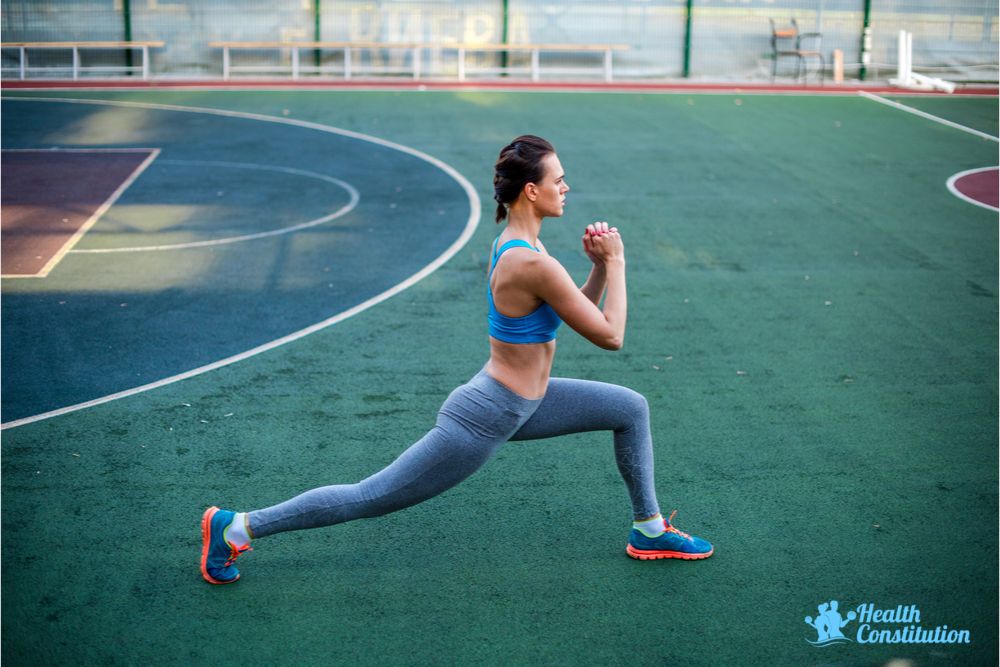
How to warm up before a free weight exercise session?
You should always warm up before doing any physical exercise. This is inexcusable so the same applies to free weight training as well.
Proper warm-ups can reduce the risk of exercise injury significantly. It can also help with increased flexibility and range of motion, which is an added advantage when lifting weights.
A study showed that an increased range of motion can lead to more muscle growth.
Here are some warm-ups you can do before the start of the session:
Depending on the type of movement you are about to do, you can do arm circles, shoulder rolls, lunges and squats.
2. Cardio
Increase the heart rate and body temperature by doing a light jog. You can do this on a treadmill or any other cardio machine like the elliptical cross trainer or exercise bike.
Spend about 5 to 10 minutes warming up your body before doing free weight exercises. Having a good warm-up session is very beneficial for the muscles because it helps the muscles to contract and relax more easily.
Thus, giving you a better workout experience as the muscles will be less strenuous for the workout.
Now that you are better prepared for the exercises, allow me to introduce you to 13 of my favourite free weight exercises you can do at home.
13 Free Weight Exercises You Can Do At Home
Here are 13 of my favourite free weight exercises, which I regularly do. All you need is either a pair of dumbbells, a kettlebell or a barbell. Feel free to research more on the different variations of these exercises to suit your fitness levels.
Please note that the number of sets and reps are listed as guides only. You need to be the judge or do more research on the exact numbers suitable for your fitness levels and goals.
The exact load or weights of free weights for each exercise are not listed as different people have different thresholds in terms of the weights they can comfortably use.
Click on the links below to jump to individual exercises.
- Concentration Curl
- Dumbbell Bench Press
- Dumbbell Clean
- Goblet Squat
- Farmer’s Walk
- One Arm Swing
- Renegade Row
- Bent Over Row
- Step Ups
- Lying Dumbbell Tricep Extensions
- Overhead Press
- Hip Thrust
- Split Squats
Concentration Curl
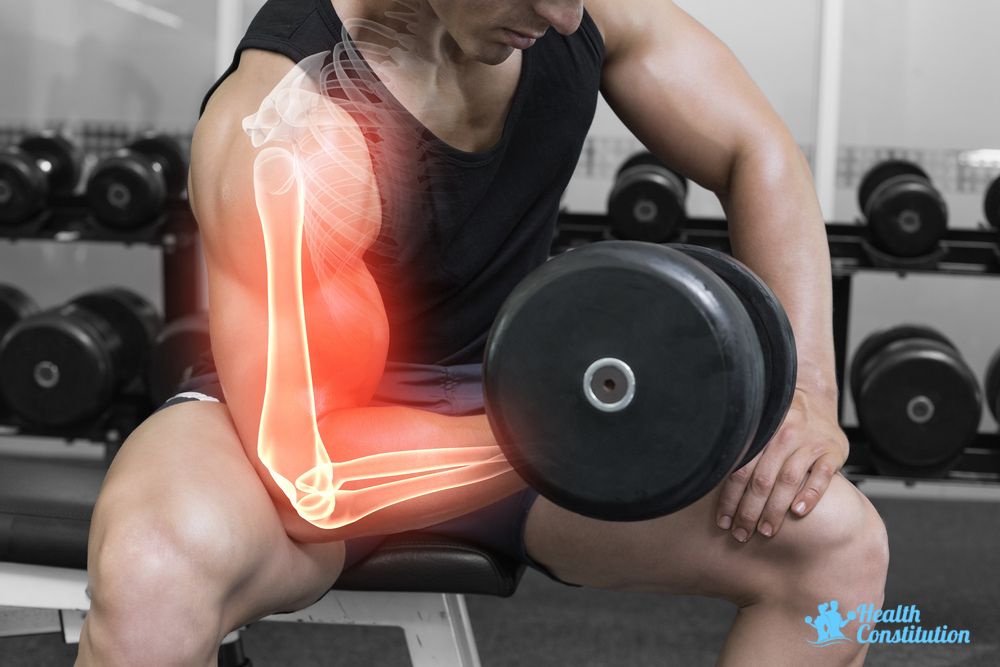
Muscles Worked: Biceps and Brachialis
Benefit: Increase upper arms strength
How: –
- Get a stable seat like the bench, and set the height so that your knees are bent at a 90-degree angle when you sit with feet flat on the floor.
- Position your legs pointing outwards at a 45-degree angle.
- Place your right upper arm on your right thigh, holding a dumbbell. The back part of your upper arm should be on the inner part of your right thigh.
- Gently start applying pressure and curl the dumbbell up to the chest moving only the forearm.
- Hold the dumbbell for a bit while squeezing the biceps once you reach your chest, before gently lowering the dumbbell to starting position.
- Complete the reps on your right arm then switch to your left and repeat the reps.
Routine: 6-10 reps (2-3 sets)
Note: Concentration curl is not to be confused for bicep curl, which has a different starting position. Use weights that you are comfortable lifting while still providing enough resistance for your to benefit from the exercise. Never overload your elbow joints by doing more reps than you can take.
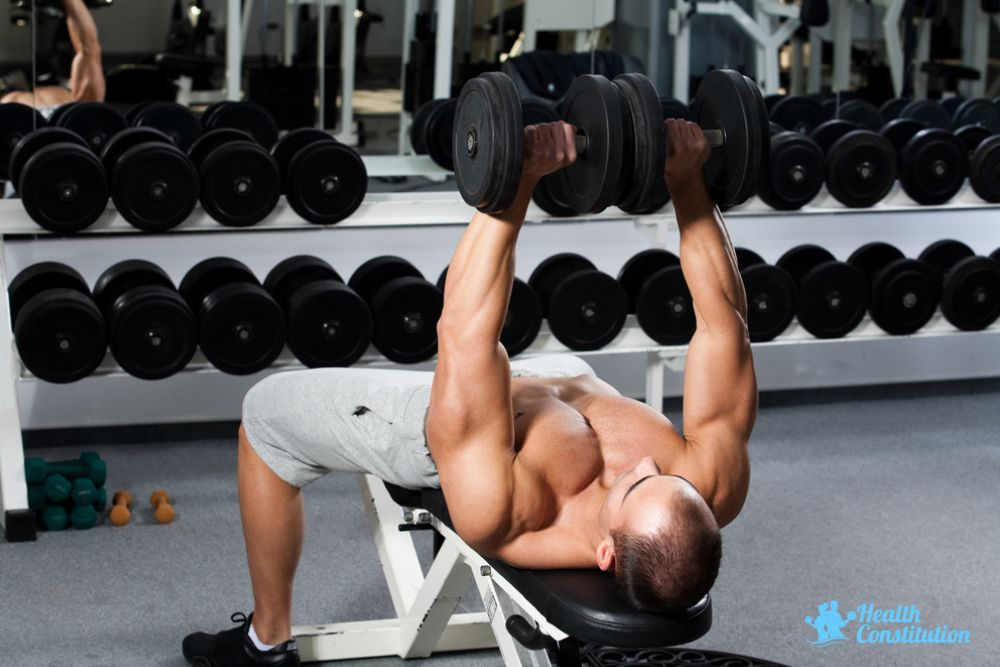
Dumbbell Bench Press
Muscles Worked: Upper body muscles (traps, lats, pecs, shoulders, triceps, forearms)
Benefit: Increase upper body strength, improve range of motion, activate the core
How: –
- Lie flat on an even surface. You can lie on the floor with a mat on top or use an incline bench.
- Using an overhand grip, slowly lift the weights from the chest upwards until your arms are straight.
- Squeeze your pectoral muscles at the highest and lowest part of the lift.
- Slowly bring your arms down to the chest, completing one rep.
Routine: 10-12 reps (3-4 sets)
Note: If you are a beginner to dumbbell bench press, start with 1 dumbbell, having the other hand to support if you are a beginner (switch and repeat) or using heavier weights than you are used to. Never drop the dumbbell next to you when you complete a rep to avoid injury to your rotator cuff and muscle tear.
Dumbbell Clean
Muscles Worked: Glutes, Calves, Biceps, Quads
Benefit: Activate stabiliser muscles
How: –
- Stand with your feet shoulder-width apart.
- Start by assuming a squat position (back should be flat) with dumbbells on the floor.
- Hold your dumbbells (keep on the outside of the feet) and flip your wrist outwards as you bring the weights to your shoulders.
- As you lift, your body should slightly bounce.
- Once at shoulder level, gradually straighten your legs to stand, then drop the dumbbells to your thigh.
- Go back to a squat position. Repeat.
Routine: 10-12 reps (3-4 sets)
Note: Not for beginners, use lighter weights, more reps and shorter rest periods for endurance.
Goblet Squat
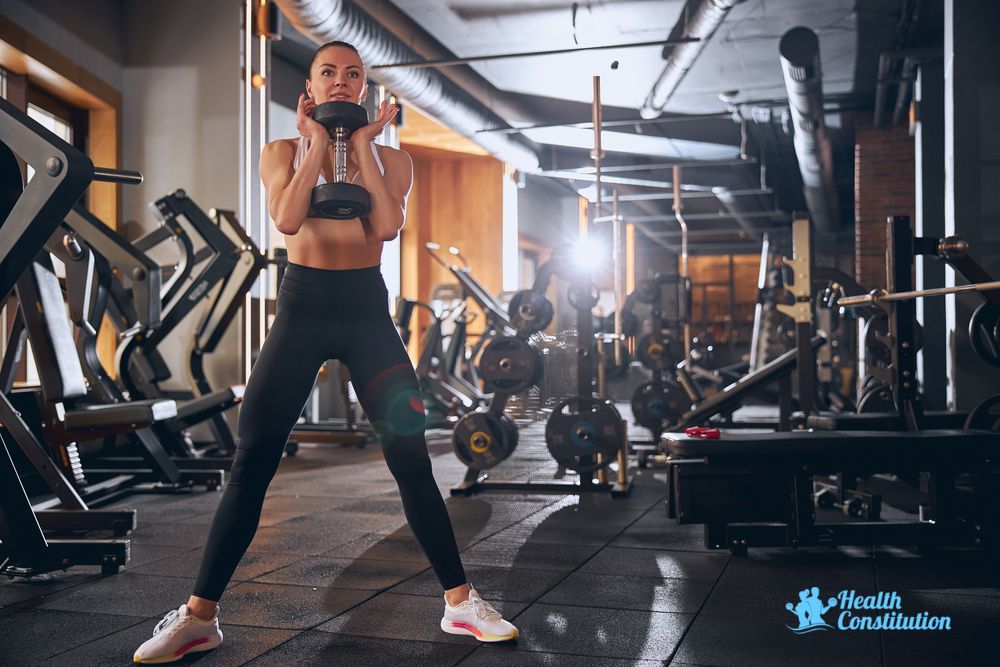
Muscles Worked: Quads and Glutes
Benefit: Strengthen core, glutes and grip strength
How: –
- Stand tall, feet shoulder-width apart, holding the dumbbell by cupping your hands (both palms facing up) against the bottom of the upper end of the dumbbell.
- Hold the dumbbell close to your chest.
- Begin squats, keeping a straight back. (Squeeze your glutes as you squat up and down)
Routine: 8-10 reps (3-4 sets)
Note: Do lesser reps if you are using heavier weights for training strength instead of endurance.
Read the details on how to do goblet squats in this post.
Farmer’s Walk
Watch video demonstration below:
Muscles Worked: Full body workout (abs, biceps, triceps, forearms, quads, glutes, calves, hamstrings, back, traps, lats)
Benefit: Better posture
How:-
- Position 2 dumbbells on the floor with you standing between shoulder-width apart (enough space so you can squat down).
- Squat down and pick up the dumbbells, keeping your back straight as you stand.
- Hold the weights tight and begin walking in a straight line, varying your pace, from slow to fast (to feel the increased intensity)
Routine: 30 seconds (3 sets)
Note: Start with lighter weights to ensure proper form and safety.
One Arm Swing

Muscles Worked: Quads, Glutes, Abs, Hamstrings, Traps
Benefit: Full body workout (improve overall fitness)
How: –
- Stand with your legs slightly wider than your shoulders.
- Drop to a squat
- Swing the weight upwards, passing through your legs
- Bring the weight up to your heads, while slowly straightening your legs
- Switch and repeat with the other arm.
Routine: 8-10 reps (2-3 sets)
Note: Use either a dumbbell or kettlebell. Use momentum to swing the weight upward, not actively lifting the weight with your arm.
Renegade Row
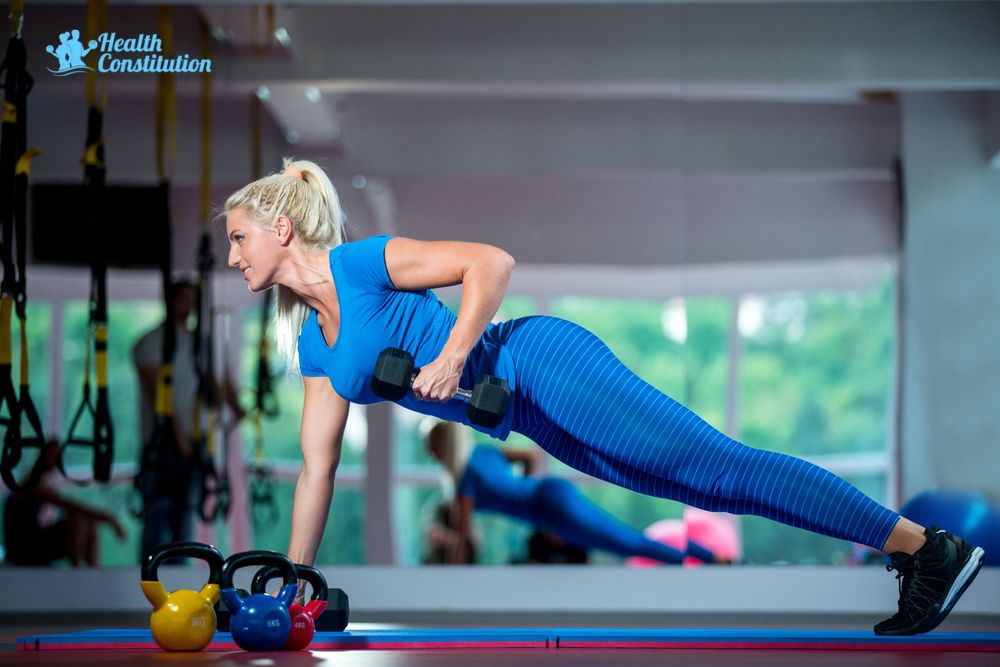
Muscles Worked: Core, Back and Triceps
Benefit: Increase upper body strength (one of the best upper body exercises), promote balance
How:-
- Set dumbbells on the floor, one on your left and one on your right so that they are accessible to you when you.
- Assume a high plank position. Keep feet hip-width apart for more stability.
- Use your right arm to pick up the dumbbell on the right and pull it towards your chest.
- Gently lower the dumbbell to the floor.
- Switch arm and repeat.
Routine: 8-10 reps (3 sets)
Note: Always check your form to make sure you are engaging the core properly. Stop immediately if you experience pain when doing this exercise.
Bent Over Row
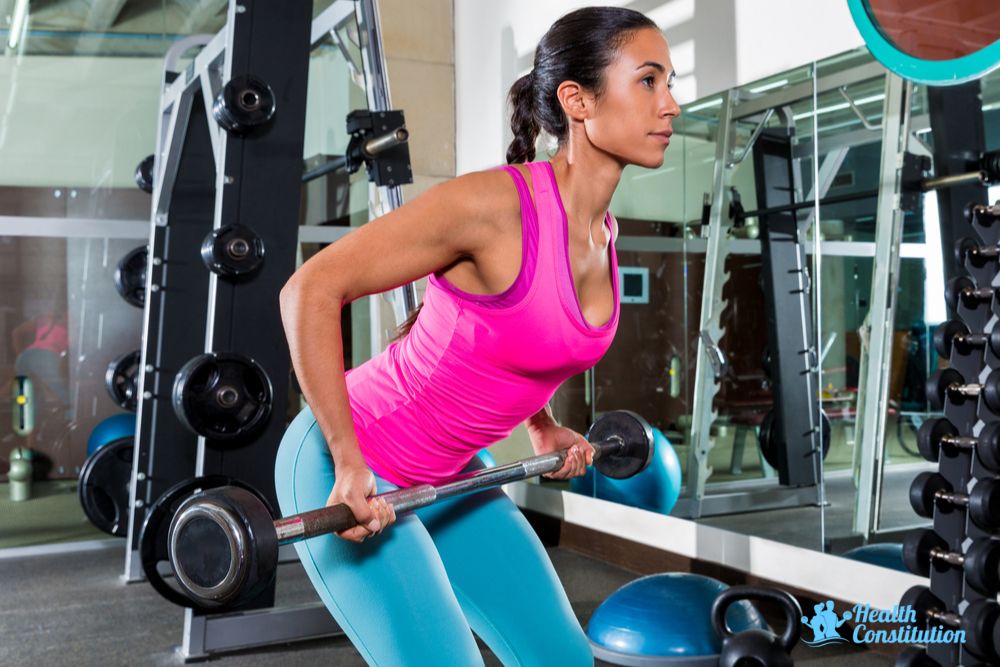
Muscles Worked: Lats, Traps and Delts
Benefit: Improve strengths in back muscles, glutes, hamstrings and shoulders
How: –
- Stand with feet shoulder-width apart.
- Hold the barbell with palms facing up.
- Slight bend on your knees.
- Bend your waist forward while maintaining a straight back.
- Keeping elbows close to your body, start lifting the barbell towards your chest.
- Gently lower the barbell to the starting position and repeat.
Routine: 10-12 reps (3-4 sets)
Note: Use a lighter weight to ensure you have a proper form when doing the exercise.
Step-Ups
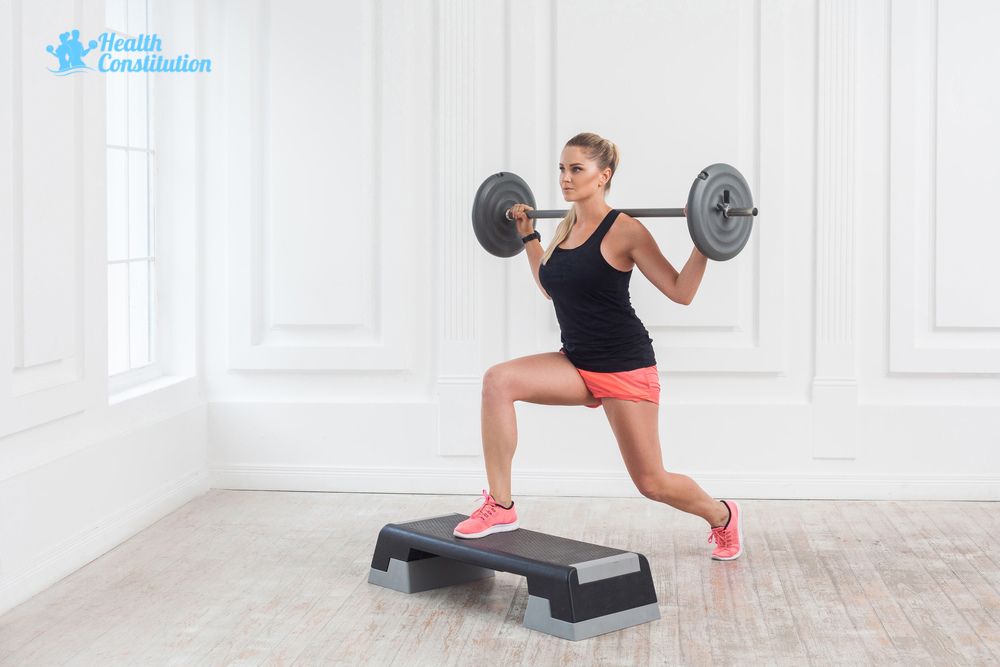
Muscles Worked: Glutes, Quads, Hamstrings
Benefit: Increase leg strength and promote balance and core strength, complements upper body exercises for strength training
How: –
- Start doing the Step Up exercise by placing your right foot onto the stepper.
- Then lift yourself and place the other foot on the platform. You should be standing on the platform by now.
- Begin your descent by lowering your left foot first, then right. All the while, you must keep weights at your side.
Routine: 6-10 reps (2-3 sets)
Note: Maintain proper form when doing free weight step-ups. As a precautionary measure, the platform should be sturdy and fixed on a non-sliding floor.
Lying Dumbbell Tricep Extension
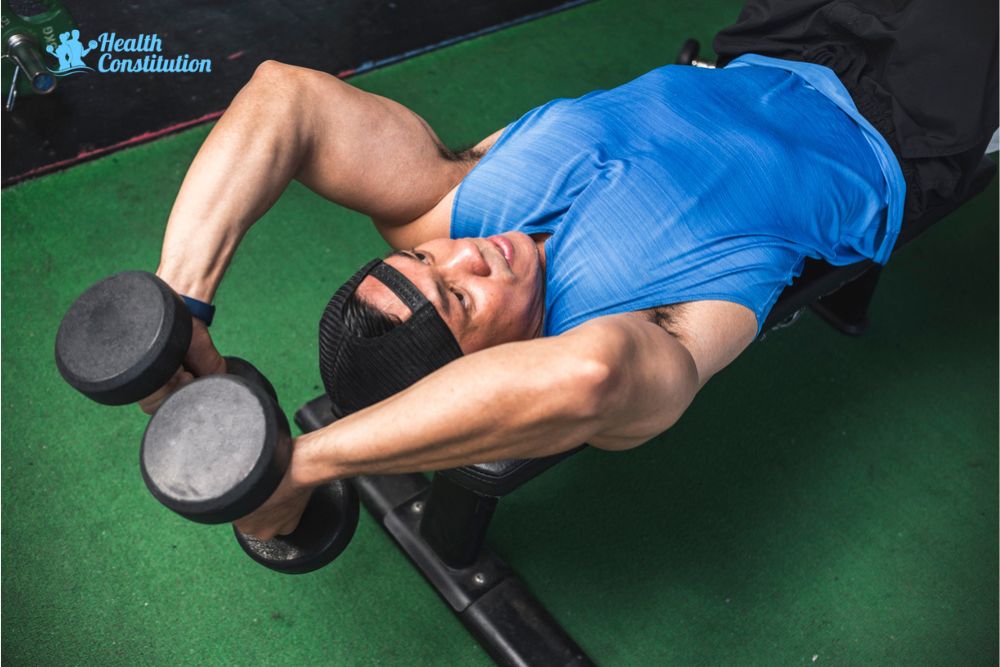
Muscles Worked: Triceps
Benefit: Strengthen triceps, increase range of motion in the shoulders
How: –
- Lie on a bench with feet flat on the floor (face up).
- Hold a pair of dumbbells with arms straight up, palms facing each other.
- Bend your elbows and lower the dumbbells to the side of your head without moving the upper arms.
- Gently raise the dumbbells back to starting position and repeat the reps.
Routine: 12-15 reps (2-3 sets)
Note: Not for beginners. Use lighter weights and get someone to spot you to avoid injuries.
Overhead Press
Watch how to do overhead press below:
Muscles Worked: Triceps, Traps and Delts
Benefit: Strengthen core and shoulder muscles
How: –
- Stand with feet shoulder-width apart.
- Hold one dumbbell on each hand, palms facing each other. Bend your elbows up, holding them close to the body.
- Push the dumbbells up, arms straight above your head. Hold for a little bit before returning to the start position.
Routine: 5-8 reps (2-3 sets)
Note: Use lighter weights as a start for safety purposes.
Hip Thrust
Watch a video demonstration here:
Muscles Worked: Glutes and Hamstrings
Benefit: Stabilises lower back, promotes balance and stronger glutes
How:-
- For a safe and effective Hip Thrust exercise, find a solid and heavy bench that you can lie against.
- Get your barbell and sit on the floor.
- Position your back against the bench, then slowly bring the barbell to your hips.
- Knees bent, raise your hips off the floor until your back is straight or parallel to the floor.
- To complete the cycle, slowly lower your hips back to the floor. Repeat.
Routine: 8-10 reps (2-3 sets)
Note: Best to work with a trainer to learn the proper form and protect the spine from getting injured.
Split Squats
Watch how to do split squats below:
Muscles Worked: Quads and Glutes
Benefit: Strengthen upper body muscles
How: –
- Hold one dumbbell in each hand.
- Step forward with your right leg (into a split position)
- Lower your left knee to the floor (like a compact lunge movement).
- Return to the start position, switch legs and repeat.
Routine: 10-15 reps (3 sets)
Note: Get someone to spot you to lower the risk of injury.
Bottom Line
There are probably hundreds of dumbbell exercises and movements you can do using resistance bands, kettlebells and barbells. Free weights are so versatile, that’s why I like incorporating them into my training routine. Check out the benefits of kettlebells in this post.
While this list is not exhaustive, I hope they give you an idea of what to do while you are at the gym or if you are wanting to purchase some weights for your home.
If you are confused about what type of free weights to get, I would recommend getting a pair of adjustable dumbbells.
Compared to the usual fixed weights dumbbells, adjustable dumbbells are cost-effective because you do not need to purchase heavier weights as you get stronger. They also do not take up a lot of space in your home. Just chuck them in a corner or under the bed.
Below are some commonly asked questions about free weight workouts that you might be interested in:
FAQS
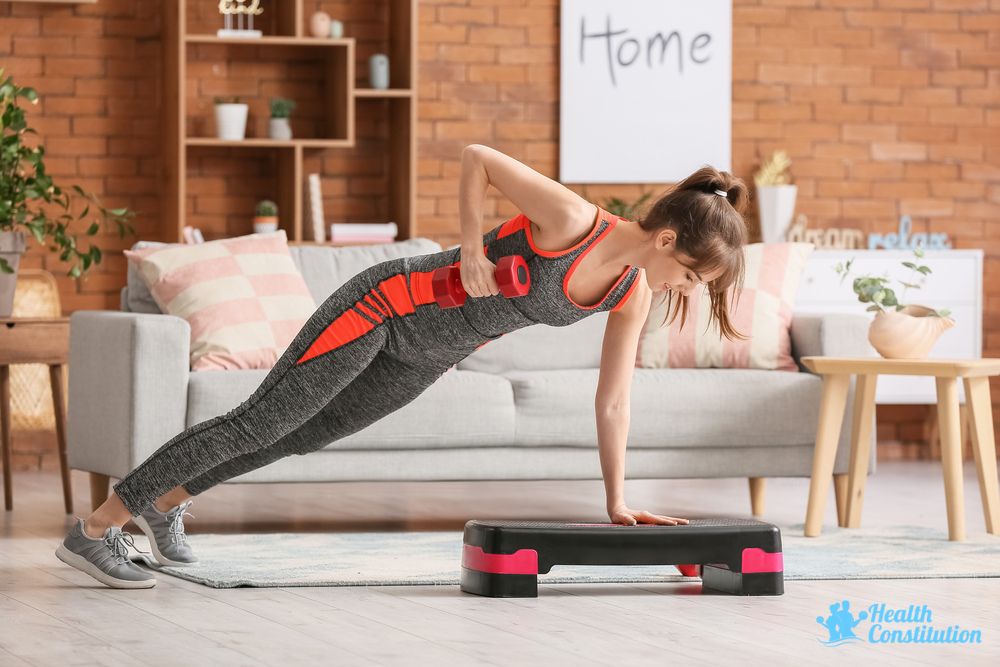
What is free weight?
Free weight is a weight that is not attached to something like a home gym machine.
It is an item that you can pick up freely and move around for lifting or resistance training, such as dumbbells, kettlebells, barbells, medicine balls and resistance bands.
What are the benefits of doing free weight exercises?
The purpose of using free weights is to train the muscles so that you build strength, balance and coordination.
While these can be trained using a weight machine, an added benefit to doing free weight exercise is that it can be done in a variety of ways.
The exercises can also be done anywhere because the weights are free to be carried around, unless they are too heavy.
Taking resistance bands, for example, is small and light so they are great for travellers who want to train while on holiday.
Are free weights any better than using gym machines?
Both free weights and machines have their own benefits so which one you choose to use is dependent on personal choice. Compared to machines, free weights are better in terms of being more efficient.
This is because you tend to work more muscles and burn more calories. Doing free weights will also work on balance and coordination. That being said, machines are better for isolating muscles for specific muscle training.
Can you build muscles with only dumbbells?
Using dumbbells can assist with building muscles. Increasing the weight of dumbbells will increase resistance, which will help in increasing strength and muscles.
There are a variety of exercises you can do with dumbbells, which can give a full-body workout, just make sure the exercises are done with proper form.
How much should I be spending on dumbbells?
Dumbbells cost more the heavier they are. It really depends on the weight you plan to use.
If you are to purchase a full set of dumbbells with a variety of weights and the stand, it could set you back almost $1000 or more.
I personally like using adjustable dumbbells because it comes in a variety of weights in the form of 1 or 2 dumbbells (brand and model differs), so it is absolutely space-efficient and cost-effective too.
Adjustable dumbbells cost about $500 to $800.
- Who Should (and Shouldn’t) Take Probiotics? - 16 November 2024
- How to Choose the Right Probiotic - 16 November 2024
- Prebiotics vs Probiotics: The Dynamic Duo of Gut Health - 16 November 2024
